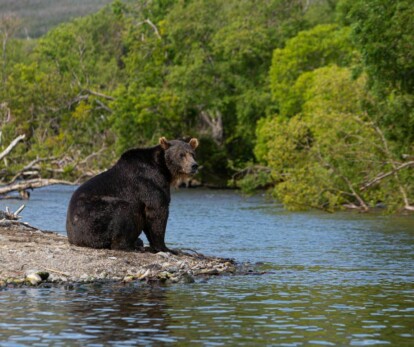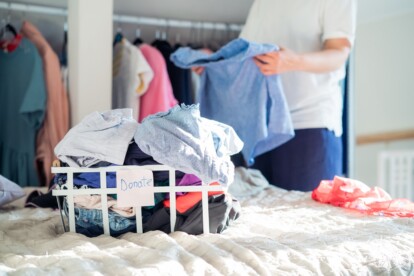Far from fair game: Why hunting must end


Are you looking for ways to make your wardrobe more sustainable?
In today’s blog, you’ll find a list of 10 ideas to help you make the most of the clothing you already own and shop for sustainable and ethical fashion brands.
Ethical and sustainable clothing brands often publically talk about how the materials they use are made or how workers in the supply chain are treated, as well as their cruelty-free credentials. After all, this is what their brand identity is built on.
Other clothing companies may be less transparent.
If you want to make your wardrobe more sustainable, you may need to dig a bit deeper into the ethical standards of your favourite brands.
Check clothing labels. What materials is an item made from? Where was it made and how?
Have a look at the brand’s website. Do they publish a “Transparency Statement” or similar document? What is their position on modern slavery/forced labour? What are they doing to make their products sustainable or cruelty-free? And what about their supply chain – how is that monitored?
If this information isn’t easy to find, it’s worth sending an email or social media message to ask questions. The more people who do this, the more brands will have to be accountable.
In 2019, a survey by Censuswide for Barnardo’s found that, in Britain alone, shoppers were expected to spend £2.7 billion over that summer on 50.3 million “throwaway outfits”, i.e. wedding outfits and holiday clothes that they only planned to wear once. Around 85% of those items were destined to end up in landfills or to be incinerated.
Everyday clothing items in the UK are worn an average of 14 times before they’re thrown away. This compares to 30 wears in France, seven wears in the US and just three wears in China.
Globally though, clothing items are worn an average of 120 times. This is because people in low-income countries and people on low incomes in wealthier parts of the world have to make their clothes last. They don’t have the disposable income to do anything else.
Instead of throwing your unwanted clothes away, look at ways to donate them.
Most local charity shops accept clothing donations but there are also organisations that send clothes to lower-income countries, recycle clothing or give clothes to people in need such as homeless people, refugees or those staying in refuge. You could also reach out to local animal sanctuaries that need warm items for bedding.
Buying second-hand is a fantastic way to give pre-loved – or previously unloved – clothes a new lease of life.
As well as charity shops, look out for vintage shops and clothing swap apps, websites and groups such as eBay, Vinted or Depop.
Or how about setting up a clothes swap group with your friends or hosting a clothes swap party?
It’s estimated that by following the care label’s instructions, you can extend the life of an item of clothing by 50-80%. In fact, up to 25% of a clothing item’s carbon footprint may come from how it’s cared for (or not cared for!)
It’s worth familiarising yourself with the care symbols on your clothing labels as these will help you prolong the wear of your favourite items, saving you money in the long run too.
Just a few decades ago, almost everyone knew how to repair their clothes. It was a skill passed down through the generations and an essential money saver.
Today, just 36% of people repair their clothes when they break. Approximately 25% say that it’s easier to buy something new than repair an item; 20% say they “can’t be bothered” to repair broken clothes and 14% say they don’t know how. Indeed, 33% of people say they wouldn’t know how to sew a button back on if it fell off.
Many clothing repairs are simple – for example, replacing a button or stitching a split seam. YouTube has some excellent tutorials for all sorts of clothing repairs.
If you think an item of clothing is beyond repair, is there a way you could repurpose the fabric?
For example, do you have children who would enjoy making sock puppets from odd socks? Could you turn their outgrown clothes into a special teddy bear or turn an old jumper into a cushion cover?
Even if you don’t have the skills to do it yourself, there are craftspeople who adjust, repair or repurpose clothes for a fee.
The fast fashion industry is built around multiple mini-seasons and peddles the idea that clothes can only be worn a few times before they’re out of date.
In reality, some items never really go out of fashion or they at least remain classic for several years.
The next time you’re shopping for a new item of clothing, how about buying something that will last for more than one season or will translate across multiple looks or styles?
You could always think about creating a capsule wardrobe for yourself. This is a limited selection of interchangeable clothing pieces that complement each other so that they can be mixed and matched into many different outfits.
With more and more of us rethinking our approach to fashion, a growing number of fashion rental services are popping up around the globe. This means that you can hire an item of clothing or accessory for a specific time period at a much cheaper price than buying it.
There are also some peer-to-peer rental schemes – marketed as the “Airbnb of fashion” – which enable anyone to monetise their wardrobes by hiring out their clothes.
If you’re someone who only wears a new item of clothing once or twice, then renting could be a great money and space saver as well as being good for the environment.
Fast fashion is made to be disposable. It’s one way that brands encourage consumers to keep buying new items. Also, it’s impossible to achieve great quality when you’re churning out great quantities of garments at breakneck speeds in dire working conditions.
Sustainable and ethical fashion brands typically favour quality over quantity, making items that are designed to be worn time and again. Yes, the initial purchase may be more expensive but, long-term, higher quality garments made from sustainable materials offer great savings.
As Giving Fashion explains, if a £30 dress is only worn five times before it breaks, each wear costs £6. If, however, you’re able to wear a £90 dress 30 times before it breaks, that costs you just £3 per wear.
To get 30 wears out of the £30 dress, you’d have to buy the same item six times at a total cost of £180, double the price of the higher quality, long-lasting garment!
Speaking of 30 wears… the next time you buy a new item of clothing, keep #30wears in mind. This hashtag stems from a challenge that was originally started by Olivia Firth of Eco-Age in which she asked participants to pledge to only buy clothes that they would wear a minimum of 30 times.
If you search for #30wears on Instagram, there are now more than 103,000 posts from people taking part in the challenge.
So, to make your wardrobe more sustainable, try asking this question before you make your next purchase:
Will I wear this item 30 times?
If the answer is no then don’t buy it.
Social media is both a blessing and a curse to the fast fashion industry.
Since social media’s earliest days, brands have used various platforms to promote trends and create a buzz about the latest “must-have” look. People turn to influencers for fashion inspiration and constantly strive to mirror their style.
But new voices are starting to rise up. People are using social media to highlight the ethical impacts of fast fashion and to promote the need for sustainability.
One way you can take action is to get rid of fast fashion brands from your newsfeeds. Instead, look for sustainable clothing brands or influencers who care about recycling or vintage style.
Instead of being bombarded with messages about what you’re lacking and what you have to buy to keep up with the latest trends, your newsfeeds will be full of positivity, progress and ways to be a more ethical consumer.
Do you run or know of an ethical fashion brand that can help people make their wardrobes more sustainable? Yes?! Then we’d love to add this business to our directory too.